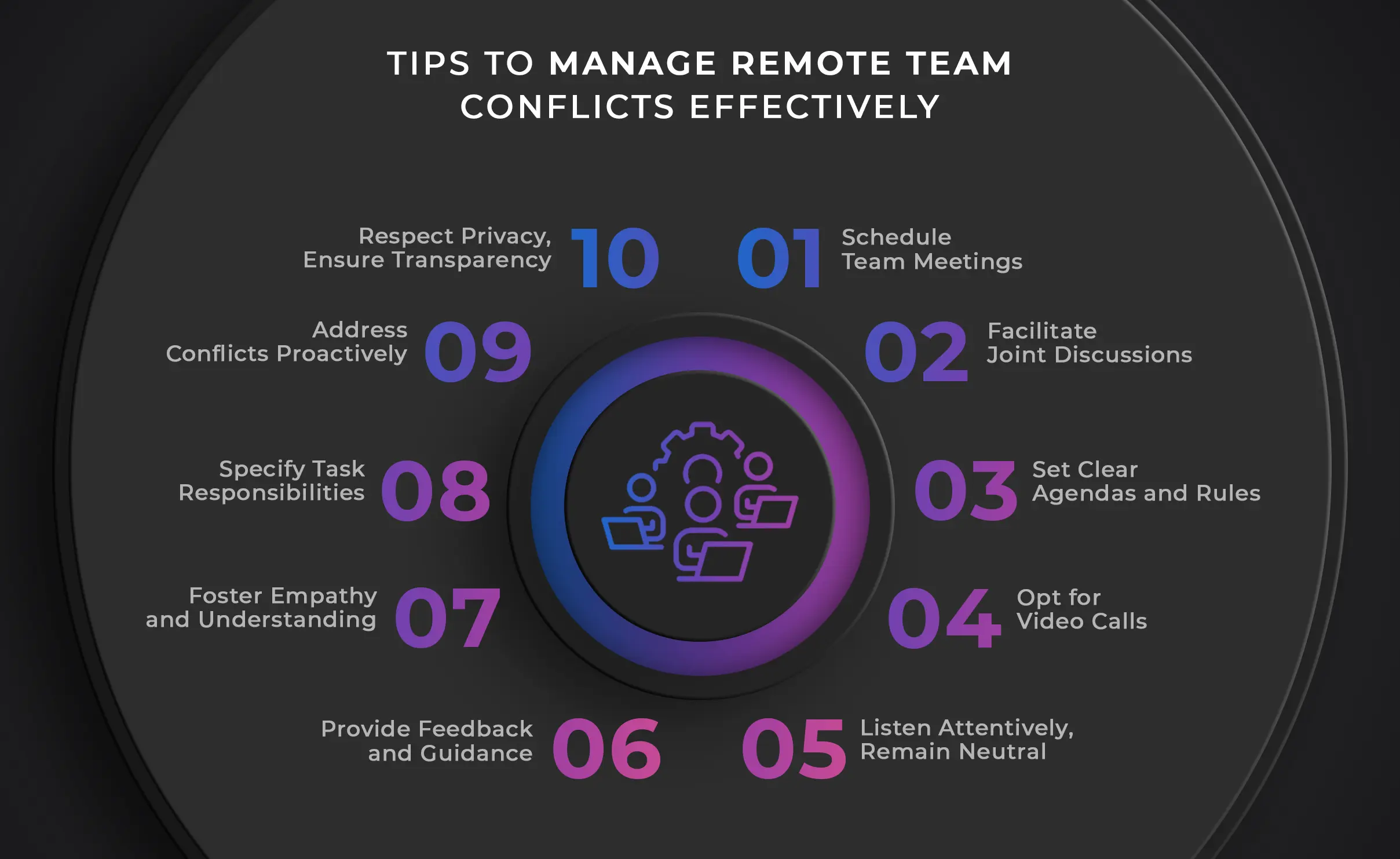Table of content
The world has stepped into a new era where teams work remotely and are connected through digital threads, working together from different corners of the globe. While this virtual collaboration offers immense flexibility and freedom, it also presents unique challenges, particularly when you have to manage conflicts.
Whether it’s miscommunication, clashing personalities, or differences in work styles, conflicts can disrupt the harmony of any remote team. But fear not! In this comprehensive guide, we will unravel the secrets to help you effectively manage conflicts and foster a harmonious virtual work environment.
Get ready to dive into practical strategies, real-life examples, and expert advice to help you navigate the complexities of conflict resolution in the workplace. From active listening techniques to virtual team-building activities, we’ll equip you with a toolkit to address conflicts head-on, build stronger relationships, and ultimately enhance productivity in your remote team.
Take a moment to pause before diving headfirst into conflict. Instead, schedule a meeting with your team members to address the situation at hand. Research suggests that holding separate meetings and then facilitating joint discussions with moderation leads to the best outcomes. For resolving conflicts in virtual teams, guide your team toward finding a solution that everyone can agree on.
Remember, not every conflict can be resolved in a single meeting. For more complex issues, establish a clear agenda, time frame, and rules of engagement for each subsequent meeting. Avoid relying on written messages and opt for video calls to enhance understanding and manage conflicts.
Listen attentively and remain neutral throughout the process. Provide feedback and guidance on how to prevent or handle future conflicts independently. Empower your team to navigate clashes with confidence, fostering a harmonious and productive work environment.
In the current scenario, where remote work has become the new norm, it’s important to acknowledge that everyone is adjusting to a different reality. People are experiencing a wide range of emotions during this transition.
To navigate this effectively, encourage open communication within your team, emphasizing the need for empathy and understanding. Remind team members to be mindful of the diverse emotional states their colleagues may be experiencing.
By fostering an environment of empathy, we can create a supportive space where everyone feels heard and understood.
When task-related conflicts persist within your team, it’s crucial to adapt the hierarchy and work procedures to fit the realm of virtual teamwork. Trying to enforce workplace processes in a remote work setting can severely hamper productivity.
To mitigate this, ensure clear task assignments with designated deadlines at the onset of each project. Hold team members accountable for their responsibilities, as accountability reduces the likelihood of clashes arising from incomplete work.
By restructuring and fostering accountability, you can pave the way for smoother collaboration and minimize conflicts in your virtual team.
When you observe or receive reports of issues, don’t ignore them. Take proactive steps to understand the areas where tensions are brewing and offer assistance. Addressing these concerns early on is crucial to prevent escalating situations.
To manage conflicts in virtual teams, be proactive. This way you can avoid having to resolve conflicts that could have been prevented altogether. Stay vigilant, promote open communication, and nip conflicts in the bud before they spiral out of control.
Respect the Privacy of Your Employees
To foster open and honest communication, teams can employ various measures to ensure privacy. One approach is granting exclusive access to team members, excluding their superiors, to secure sections of the virtual workspace, like the online discussion board.
Another option is enabling sub-groups to create private folders for discussing issues before presenting them to the entire team. Additionally, team members can engage in private conversations via instant messaging to address task-related conflicts, with the understanding that relevant information should be later shared with the team.
These strategies strike a balance between confidentiality and transparency, encouraging candid discussions while maintaining the necessary flow of information within the team.
The summarized issue is then added to the agenda for an upcoming meeting. The point person can be the team leader, the person who initially raised the concern, a willing volunteer, or any other suitable team member.
By designating a point person, the team ensures efficient management of the problem-solving process and facilitates progress toward resolving the issue at hand.
Set aside dedicated time for engaging in non-work-related activities. Remember, conflicts are bound to arise, but it’s how you respond to them that truly matters. Embrace conflicts as opportunities to strengthen your team and create a more cohesive and productive work environment.
Wrapping Up!
Effectively managing conflicts in remote teams is essential for maintaining a harmonious and productive work environment. By adopting proactive strategies and fostering open communication, remote teams can navigate conflicts with success.
The key aspect is utilizing the virtual workspace as the primary platform for addressing important task-related issues. Conflict resolution in the workplace is an important aspect that all business owners should pay close attention to.
Managers play a crucial role in setting the tone by firmly establishing the virtual workspace as the forum for such discussions. By consistently posting important emails and responses in the shared workspace, managers ensure that everyone understands the significance of utilizing this platform for project-related matters that impact the entire team.
Remember, conflict resolution is an ongoing process. It requires active listening, empathy, and a commitment to finding mutually acceptable solutions. Encouraging open dialogue, employing effective communication channels, and embracing team-building activities can further strengthen the bonds within remote teams.
Supersourcing is a smart hiring platform that is helping businesses hire and manage remote engineering teams effectively. We have a pre-designed remote setup to implement conflict resolution strategies immediately. Hence, if you want to build your own remote development team, you can reach out to us.


